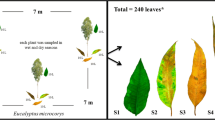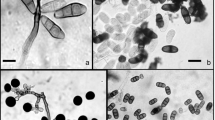Abstract
The mycota and decomposing potential of endophytic fungi associated with Acer truncatum, a common tree in northern China, were investigated. The colonization rate of endophytic fungi was significantly higher in twigs (77%) than in leaves (11%). However, there was no significant difference in the colonization rates of endophytic fungi between lamina (9%) and midrib (14%) tissues. A total of 58 endophytic taxa were recovered using two isolation methods and these were identified based on morphology and ITS sequence data. High numbers of leaf endophytes were obtained in the method to determine decomposition of leaves by the natural endophyte community (35 taxa) as compared to disk fragment methodology (9 taxa). The weight loss in A. truncatum leaves decomposed by endophyte communities increased with incubation time; the weight loss was significantly higher at 20 weeks than at 3 and 8 weeks. Both common and rare endophytic taxa produced extracellular enzymes in vitro and showed different leaf decay abilities. Our results indicated that the composition and diversity of endophytic fungi obtained differed using two isolation methods. This study suggests that endophytic fungi play an important role in recycling of nutrients in natural ecosystems.



Similar content being viewed by others
References
Albrectsen BR, Bjorken L, Varad A, Hagner A, Wedin M, Karlsson J, Jansson S (2010) Endophytic fungi in European aspen (Populus tremula) leaves diversity, detection, and a suggested correlation with herbivory resistance. Fungal Divers 41:17–28. doi:10.1007/s13225-009-0011-y
Aly AH, Debbab A, Kjer J, Proksch P (2010) Fungal endophytes from higher plants: a prolific source of phytochemicals and other bioactive natural products. Fungal Divers 41:1–16. doi:10.1007/s13225-010-0034-4
Arnold AE, Lutzoni F (2007) Diversity and host range of foliar fungal endophytes: are tropical leaves biodiversity hotspots? Ecology 88:541–549. doi:10.1890/05-1459
Barrow JR, Osuna-Avila P, Reyes-Vera I (2004) Fungal endophytes intrinsically associated with micropropagated plants regenerated from native Bouteloua eriopoda Torr. and Atriplex canescens (Pursh) Nutt. In Vitro Cell Dev Biol—Plant 40:608–612. doi:10.1079/Ivp2004584
Bills GF (1996) Isolation and analysis of endophytic fungal communities from woody plants. In: Redlin SC, Carris LM (eds) Endophytic fungi in grasses and woody plants. The American Phytopathological Society Press, St. Paul, pp 31–66
Carroll G, Petrini O (1983) Patterns of substrate utilization by some fungal endophytes from coniferous foliage. Mycologia 75:53–63
Cheplick GP, Clay K, Marks S (1989) Interactions between infection by endophytic fungi and nutrient limitaion in the grasses Lolium perenne and Festuca arundinacea. New Phytol 111:89–97. doi:10.1111/j.1469-8137.1989.tb04222.x
Collado J, Platas G, Pelaez F (2000) Host specificity in fungal endophytic populations of Quercus ilex and Quercus faginea from Central Spain. Nova Hedwig 71:421–430
Davey ML, Currah RS (2006) Interactions between mosses (Bryophyta) and fungi. Can J Bot 84:1509–1519. doi:10.1139/B06-120
Duong LM, Jeewon R, Lumyong S, Hyde KD (2006) DGGE coupled with ribosomal DNA gene phylogenies reveal uncharacterized fungal phylotypes. Fungal Divers 23:121–138
Elmi AA, West CP (1995) Endophyte infection effects on stomatal conductance, osmotic adjustment and drought recovery of tall fescue. New Phytol 131:61–67. doi:10.1111/j.1469-8137.1995.tb03055.x
Fisher PJ, Petrini O (1987) Location of fungal endophytes in tissues of Suaeda fruticosa: a preliminary study. Trans Br Mycol Soc 89:246–249. doi:10.1016/S0007-1536(87)80161-4
Fisher PJ, Anson AE, Petrini O (1986) Fungal endophytes in Ulex europaeus and Ulex gallii. Trans Br Mycol Soc 86:153–156. doi:10.1016/S0007-1536(86)80128-0
Fisher PJ, Petrini O, Petrini LE, Sutton BC (1994) Fungal endophytes from the leaves and twigs of Quercus ilex L. from England, Majorca and Switzerland. New Phytol 127:133–137. doi:10.1111/j.1469-8137.1994.tb04267.x
Gamboa MA, Laureano S, Bayman P (2003) Measuring diversity of endophytic fungi in leaf fragments: does size matter? Mycopathologia 156:41–45. doi:10.1023/A:1021362217723
Gond SK, Verma VC, Kumar A, Kumar V, Kharwar RN (2007) Study of endophytic fungal community from different parts of Aegle marmelos Correae (Rutaceae) from Varanasi (India). World J Microbiol Biotechnol 23:1371–1375. doi:10.1007/s11274-007-9375-x
Gong LJ, Guo SX (2009) Endophytic fungi from Dracaena cambodiana and Aquilaria sinensis and their antimicrobial activity. Afr J Biotechnol 8:731–736
Guo LD, Hyde KD, Liew ECY (1998) A method to promote sporulation in palm endophytic fungi. Fungal Divers 1:109–113
Guo LD, Hyde KD, Liew ECY (2000) Identification of endophytic fungi from Livistona chinensis based on morphology and rDNA sequences. New Phytol 147:617–630. doi:10.1046/j.1469-8137.2000.00716.x
Guo LD, Huang GR, Wang Y (2008) Seasonal and tissue age influences on endophytic fungi of Pinus tabulaeformis (Pinaceae) in the Dongling Mountains, Beijing. J Integr Plant Biol 50:997–1003. doi:10.1111/j.1744-7909.2008.00394x
Huang WY, Cai YZ, Surveswaran S, Hyde KD, Corke H, Sun M (2009) Molecular phylogenetic identification of endophytic fungi isolated from three Artemisia species. Fungal Divers 36:69–88
Hyde KD, Soytong K (2007) Understanding microfungal diversity: a critique. Cryptogam Mycol 28:281–289
Hyde KD, Soytong K (2008) The fungal endophyte dilemma. Fungal Divers 33:163–173
Jakucs E, Naar Z, Szedlay G, Orban S (2003) Glomalean and septate endophytic fungi in Hypopterygium mosses (Bryopsida). Cryptogam Mycol 24:27–37
Korkama-Rajala T, Müeller MM, Pennanen T (2008) Decomposition and fungi of needle litter from slow- and fast-growing norway spruce (Picea abies) clones. Microb Ecol 56:76–89. doi:10.1007/s00248-007-9326-y
Krings M, Taylor TN, Hass H, Kerp H, Dotzler N, Hermsen EJ (2007) Fungal endophytes in a 400-million-yr-old land plant: infection pathways, spatial distribution, and host responses. New Phytol 174:648–657. doi:10.1111/j.1469-8137.2007.02008.x
Kumar DSS, Hyde KD (2004) Biodiversity and tissue-recurrence of endophytic fungi in Tripterygium wilfordii. Fungal Divers 17:69–90
Kumaresan V, Suryanarayanan TS (2002) Endophyte assemblages in young, mature and senescent leaves of Rhizophora apiculata: evidence for the role of endophytes in mangrove litter degradation. Fungal Divers 9:81–91
Lacap DC, Hyde KD, Liew ECY (2003) An evaluation of the fungal ‘morphotype’ concept based on ribosomal DNA sequences. Fungal Divers 12:53–66
Li WC, Zhou J, Guo SY, Guo LD (2007) Endophytic fungi associated with lichens in Baihua mountain of Beijing, China. Fungal Divers 25:69–80
Malinowski DP, Brauer DK, Belesky DP (1999) The endophyte Neotyphodium coenophialum affects root morphology of tall fescue grown under phosphorus deficiency. J Agron Crop Sci 183:53–60. doi:10.1046/j.1439-037x.1999.00321.x
Mohamed R, Jong PL, Zali MS (2010) Fungal diversity in wounded stems of Aquilaria malaccensis. Fungal Divers 43:67–74. doi:10.1007/s13225-010-0039-z
Mucciarelli M, Scannerini S, Bertea C, Maffei M (2003) In vitro and in vivo peppermint (Mentha piperita) growth promotion by nonmycorrhizal fungal colonization. New Phytol 158:579–591. doi:10.1046/j.1469-8137.2003.00762.x
Muller CB, Krauss J (2005) Symbiosis between grasses and asexual fungal endophytes. Curr Opin Plant Biol 8:450–456. doi:10.1016/j.pbi.2005.05.007
Müller MM, Valjakka R, Suokko A, Hantula J (2001) Diversity of endophytic fungi of single Norway spruce needles and their role as pioneer decomposers. Mol Ecol 10:1801–1810. doi:10.1046/j.1365-294X.2001.01304.x
O’Brien HE, Parrent JL, Jackson JA, Moncalvo JM, Vilgalys R (2005) Fungal community analysis by large-scale sequencing of environmental samples. Appl Environ Microb 71:5544–5550. doi:10.1128/AEM.71.9.5544-5550.2005
Olsrud M, Michelsen A, Wallander H (2007) Ergosterol content in ericaceous hair roots correlates with dark septate endophytes but not with ericold mycorrhizal colonization. Soil Biol Biochem 39:1218–1221. doi:10.1016/j.soilbio.2006.11.018
Osono T, Hirose D (2009) Effects of prior decomposition of Camellia japonica leaf litter by an endophytic fungus on the subsequent decomposition by fungal colonizers. Mycoscience 50(1):52–55. doi:10.1007/s10267-008-0442-4
Osono T, Takeda H (2006) Fungal decompostion of Abies needle and Betula leaf litter. Mycologia 98:172–179. doi:10.3852/mycologia.98.2.172
Pinruan U, Rungjindamai N, Choeyklin R, Lumyong S, Hyde KD, Jones EBG (2010) Occurrence and diversity of basidiomycetous endophytes from the oil palm, Elaeis guineensis in Thailand. Fungal Divers 41:71–88. doi:10.1007/s13225-010-0029-1
Pinto LSRC, Azevedo JL, Pereira JO, Vieira MLC, Labate CA (2000) Symptomless infection of banana and maize by endophytic fungi impairs photosynthetic efficiency. New Phytol 147:609–615. doi:10.1046/j.1469-8137.2000.00722.x
Promputtha I, Lumyong S, Lumyong P, McKenzie EHC, Hyde KD (2002) Fungal succession on senescent leaves of Manglietia garrettii in Doi Suthep-Pui National Park, northern Thailand. Fungal Divers 10:89–100
Promputtha I, Jeewon R, Lumyong S, McKenzie EHC, Hyde KD (2005) Ribosomal DNA fingerprinting in the identification of non sporulating endophytes from Magnolia liliifera (Magnoliaceae). Fungal Divers 20:167–186
Promputtha I, Lumyong S, Dhanasekaran V, McKenzie EHC, Hyde KD, Jeewon R (2007) A phylogenetic evaluation of whether endophytes become saprotrophs at host senescence. Microb Ecol 53:579–590. doi:10.1007/s00248-006-9117-x
Promputtha I, Hyde KD, McKenzie EHC, Peberdy JF, Lumyong S (2010) Can leaf degrading enzymes provide evidence that endophytic fungi becoming saprobes? Fungal Divers 41:89–99. doi:10.1007/s13225-010-0024-6
Rodrigues KF (1994) The foliar fungal endophytes of the Amazonian palm Euterpe oleracea. Mycologia 86:376–385
Saikkonen K, Saari S, Helander M (2010) Defensive mutualism between plants and endophytic fungi? Fungal Divers 41:101–113. doi:10.1007/s13225-010-0023-7
Sakayaroj J, Preedanon S, Supaphon O, Jones EBG, Phongpaichit S (2010) Phylogenetic diversity of endophyte assemblages associated with the tropical seagrass Enhalus acoroides in Thailand. Fungal Divers 42:27–45. doi:10.1007/s13225-009-0013-9
Schulz B, Boyle C (2005) The endophytic continuum. Mycol Res 109:661–686. doi:10.1017/S095375620500273X
Selosse MA, Vohnik M, Chauvet E (2008) Out of the rivers: are some aquatic hyphomycetes plant endophytes? New Phytol 178:3–7. doi:10.1111/j.1469-8137.2008.02390.x
Sokal RR, Rohlf FJ (1981) Biometry. W. H. Freeman and Company, San Francisco
Sokolski S, Piché Y, Chauvet É, Bérubé JA (2006) A fungal endophyte of black spruce (Picea mariana) needles is also an aquatic hyphomycete. Mol Ecol 15:1955–1962. doi:10.1111/j.1365-294X.2006.02909.x
Su YY, Guo LD, Hyde KD (2010) Response of endophytic fungi of Stipa grandis to experimental plant function group removal in Inner Mongolia steppe, China. Fungal Divers 43:93–101. doi:10.1007/s13225-010-0040-6
Sun J, Guo L, Zang W, Ping W, Chi D (2008) Diversity and ecological distribution of endophytic fungi associated with medicinal plants. Sci China C Life Sci 51:751–759. doi:10.1007/s11427-008-0091-z
Suryanarayanan TS, Thirunavukkarasu N, Hariharan GN, Balaji P (2005) Occurrence of non-obligate microfungi inside lichen thalli. Sydowia 57:120–130
Swatzell LJ, Powell MJ, Kiss JZ (1996) The relationship of endophytic fungi to the gametophyte of the fern Schizaea pusilla. Int J Plant Sci 157:53–62
Ting ASY, Meon S, Kadir J, Radu S, Singh G (2008) Endophytic microorganisms as potential growth promoters of banana. Biocontrol 53:541–553. doi:10.1007/s10526-007-9093-1
Unterseher M, Schnittler M (2009) Dilution-to-extinction cultivation of leaf-inhabiting endophytic fungi in beech (Fagus sylvatica L.)—Different cultivation techniques influence fungal biodiversity assessment. Mol Ecol 113:645–654. doi:10.1016/j.mycres.2009.02.002
Unterseher M, Reiher A, Finstermeier K, Otto P, Morawetz W (2007) Species richness and distribution patterns of leaf-inhabiting endophytic fungi in a temperate forest canopy. Mycol Progr 6:201–212. doi:10.1007/s11557-007-0541-1
Wang Y, Guo LD (2007) A comparative study of endophytic fungi in needles, bark, and xylem of Pinus tabulaeformis. Can J Bot 85:911–917. doi:10.1139/B07-084
White TJ, Bruns T, Lee S, Taylor J (1990) Amplification and direct sequencing of fungal ribosomal RNA genes for phylogeneics. In: Innis MA, Gelfand DH, Sninsky JJ, White TJ (eds) PCR protocols: a guide to methods and applications. Academic, San Diego, pp 315–322
Xu J, Ebada SS, Proksch P (2010) Pestalotiopsis a highly creative genus: chemistry and bioactivity of secondary metabolites. Fungal Divers. doi:10.1007/s13225-010-0055-z
Acknowledgements
This project is supported by the National Natural Science Foundation of China Grants (No. 30930005 and 30870087) and the Chinese Academy of Sciences Grant (No. KSCX2-YW-Z-0935).
Author information
Authors and Affiliations
Corresponding author
Rights and permissions
About this article
Cite this article
Sun, X., Guo, LD. & Hyde, K.D. Community composition of endophytic fungi in Acer truncatum and their role in decomposition. Fungal Diversity 47, 85–95 (2011). https://doi.org/10.1007/s13225-010-0086-5
Received:
Accepted:
Published:
Issue Date:
DOI: https://doi.org/10.1007/s13225-010-0086-5




